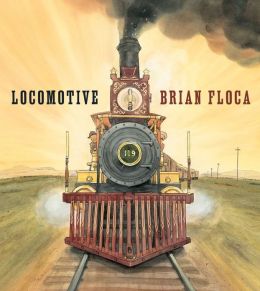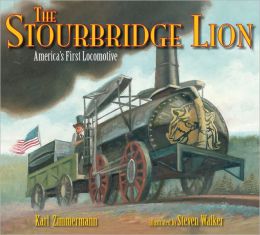Every year children’s publishing offers at least one major picture book related to trains, but this year we’ve been blessed with three. One of them, Sherri Rinker’s Steam Train, Dream Train, we’ve  already reviewed. The other two, Brian Floca’s Locomotive and Elisha Cooper’s Train, were released within weeks of each other, and both to glowing reviews. With a nod to history month, and a look ahead to picture book month (November), this seems like a good place to slide them in—plus one extra, published last year.
already reviewed. The other two, Brian Floca’s Locomotive and Elisha Cooper’s Train, were released within weeks of each other, and both to glowing reviews. With a nod to history month, and a look ahead to picture book month (November), this seems like a good place to slide them in—plus one extra, published last year.
Locomotive, by Brian Floca. Atheneum, 2013, 65 pages. Age/interest level: all
Here is a road/ made for crossing the country,/ a new road of rails/made for people to ride. It’s the transcontinental railroad, the “wonder of the age,” built at great speed and risk over hundreds of miles of open prairie from Omaha to Sacramento. The front endpages describe how it was planned and built, with a little more background at the beginning. Turn a page, and Here your trip begins/at the depot, on the platform. It’s a ride across America, ca. 1870, in a wooden car pulled by a coal-burning locomotive (complete with sound effects, louder and louder as the magnificent machine chugs up to the station platform). Every detail of the overland journey, from news butchers to the corner “convenience” (toilet), to landmarks along the way, is narrated as though we were right there. And along the way the traveler will gain a lot of information about the way railroads worked: firebox, link & pin couplers, trestle bridges (rickety rickety rickety), wheel brakes.
Author and illustrator Floca is clearly enthusiastic about his subject, explaining in the Afterward how he got interested in trains and what sort of research he did for the book. It includes acting as engineer on a steam locomotive himself, and the back endpapers show us an exploded diagram of how a simple principle—water expands when it’s heated—was channeled into the engine of the industrial revolution. The deceptively simple text is meant to be read aloud, and mesmerizing if read well. My husband, whose life and career has revolved around trains, gives this book an A+. All the would-be engineers in your house will, too.
 Train, by Elisha Cooper. Scholastic, 2013, 40 pages. Age/interest level: 4-8.
Train, by Elisha Cooper. Scholastic, 2013, 40 pages. Age/interest level: 4-8.
In an undetermined time that feels like the 1950s and a place that resembles the United States, trains are busily cris-crossing the nation carrying people and goods. We begin with a commuter train in a large city and leave it behind as a passenger train whooshes by on its way to the Midwest. “As the train approaches a rail crossing, it sounds like a storm. As the train passes, it sounds like dropped pots and pans.” In the outskirts of a midwestern industrial city, where “everything smells of grease and rust and burnt toast,” we switch over to a long mixed freight with fascinating markings and containers “the color of tomatoes and eggs.” Slowly we travel across the great plains and into the Rockies, where we meet another passenger train and spend a night with the travelers in their overhead berths. In the morning, different scenery greets us—also a phantom-like high-speed train that whooshes by to a futuristic-looking station: passengers on, passengers off. We’re no longer in the fifties, but a nonexistent future where both high-speed and regular passenger trains run smoothly and at full capacity. It’ll never happen, but train lovers will enjoy dreaming along with Train.
The Stourbridge Lion: America’s First Locomotive, by Karl Zimmermann, illustrated by Steven Walker. Boyd’s Mill Press, 2012, 30 pages. Age/interest level: 4-8.
Back in the early 19th century a father and son team named Stevenson began tinkering with steam-powered locomotives in the English countryside. Predictable disasters occurred, but they (and others)  kept at it, and by the time Horatio Allen of Honesdale PA went to England to Purchase a steam locomotive, there was no turning back. The Stourbridge Lion (named for the animal painted on the boiler front) was not the only engine Allen purchased, but it was the first to arrive in the US. Honesdalians were too frightened to actually ride the thing; Allen had to take the first trip by himself, acting as engineer and fireman both. The trip was successfully completed, meaning another set of problems, mainly having to do with track. I would have liked a little more exposition; and important developments in the story are left out, but it’s a significant piece of history that deserves more attention.
kept at it, and by the time Horatio Allen of Honesdale PA went to England to Purchase a steam locomotive, there was no turning back. The Stourbridge Lion (named for the animal painted on the boiler front) was not the only engine Allen purchased, but it was the first to arrive in the US. Honesdalians were too frightened to actually ride the thing; Allen had to take the first trip by himself, acting as engineer and fireman both. The trip was successfully completed, meaning another set of problems, mainly having to do with track. I would have liked a little more exposition; and important developments in the story are left out, but it’s a significant piece of history that deserves more attention.
While we’re talking about trains, don’t miss our interview with Sherri Rinker, author of Steam Train, Dream Train.
Support our writers and help keep Redeemed Reader ad-free by joining the Redeemed Reader Fellowship.
Stay Up to Date!
Get the information you need to make wise choices about books for your children and teens.
Our weekly newsletter includes our latest reviews, related links from around the web, a featured book list, book trivia, and more. We never sell your information. You may unsubscribe at any time.
We'd love to hear from you!
Our comments are now limited to our members (both Silver and Golden Key). Members, you just need to log in with your normal log-in credentials!
Not a member yet? You can join the Silver Key ($2.99/month) for a free 2-week trial. Cancel at any time. Find out more about membership here.
1 Comments
Leave a Comment
You must be logged in to post a comment.


I thought Locomotive was amazing, but then, I’m a fan of Floca’s picture books! I haven’t gotten my hands on Cooper’s work, but I really like the deceptive simplicity of his picture books, too.